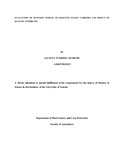| dc.description.abstract | Mango is one of the most cultivated fruits in Kenya for export and domestic markets. One of the major challenges facing mango producers in Kenya is lack of knowledge of the right harvest maturity for the different markets or uses. Maturity at harvest determines not only the postharvest longevity but also the fruit‘s nutritional and sensory quality. The present study‘s objective was to establish maturity indices, quality attributes during the ripening process and the effect of harvest maturity on processed products of 3 commercial mango varieties; ‗Tommy Atkins‘,‘ Van dyke‘ and ‗Kent‘. It was conducted in Embu County, between August 2014 and March 2016. A total of 54 mango trees of varieties ‗Tommy Atkins‘,‘ Van dyke‘ and ‗Kent‘, of similar vigor and aged at least 8 years were randomly tagged at 50% flowering in 3 small scale farms. The number of days from 50% flowering to physiological maturity (based on flesh color) was established for each variety as stage 1 from which stages 2, 3 and 4 were established. For each maturity stage, the initial physical (size, specific gravity, peel/flesh firmness and peel/flesh color); physiological (ethylene evolution and respiration rates) and biochemical maturity indices were determined. Additionally, nutritional quality attributes of the fruits including Vitamin C, β-carotene, major sugars (sucrose, fructose and glucose) and mineral nutrients (potassium, calcium, magnesium, sodium and iron) were determined for each maturity stage. A random sample of five fruits was also taken from the pool every 3 days to determine the shelf life and nutritional quality changes during storage until a predetermined end stage. At the end stage, the fruits were diced and subjected to sensory evaluation by 34 untrained panellists. Mango fruits harvested at stages 3 and 4 from each variety were solar dried in a small scale green house and analysed for changes in nutritional qualities and physical properties. Data collected was analyzed using Genstat statistical package 13th edition. Means were separated using Fisher‘s protected Least Significance Difference (LSD) at P ≤ 0.05. The sensory evaluation data was analyzed using Statistical Package for the Social Sciences (SPSS). The results showed that maturity indices evaluated and ripening related changes were all significantly (p≤ 0.05) affected by maturity stage and variety. The 3 varieties attained a comparative physiological maturity (stage 1) at different times, 97, 100 and 114 days after flowering for ‗Tommy Atkins‘, ‗Van dyke‘ and ‗Kent‘ respectively. The physical parameters including size, firmness and color varied significantly (p≤0.05) with the
stage of maturity and variety. Ethylene evolution and respiration rate increased with maturity stages and were significantly different (p≤ 0.05) among the varieties. ‗Kent‘ had the lowest ethylene levels and respiration rate compared to Van dyke and Tommy atkins varieties.
Total soluble solids increased from 7.190Brix (stage 1) to 13.93 0Brix (stage 4) while total titratable acidity decreased from 0.2817 % citric acid equivalent (stage 1) to 0.132 % citric acid (stage 4) depending with the variety. The highest TSS levels were recorded in ‗Kent‘ rising from 7.847 0Brix at stage 1 to 13.930Brix at stage 4. Higher TTA levels were recorded in ‗Van dyke‘ compared to ‗Tommy Atkins‘ and ‗Kent‘.
Vitamin C, potassium, magnesium, calcium, iron and sodium reduced significantly with advancing maturity and ripening. At the end of ripening period, Van dyke variety had the highest ascorbic acid content of 51.82 mg/100g at maturity stage 1 while Kent variety had the highest potassium contents of 195mg/100g and 119 mg/100g during early and advanced maturities. Beta carotene and the sugars (fructose, sucrose and glucose) increased significantly (p≤ 0.05) with ripening. At maturity stage 4, Kent variety had the highest β-carotene contents of 13.354 mg/100g at the end of ripening period. Tree ripe stage scored highest for all the sensory attributes in all the varieties compared to maturity stages 3 and 4 while ‗Van dyke‘ variety received highest scores for all sensory attributes except succulence at maturity stages 3 and 4. The color (hue angle) of the mango juice and the solar dried slices was significantly different (p≤0.05) within the stages. Moisture content was significantly (p≤0.05) affected by maturity stage and the varietal differences. The results show that maturity indices of mango fruits vary across varieties and that harvest maturity has an effect on the shelf life, nutritional quality and physical properties of the fresh fruits and processed products.
Key words: Mango, Maturity indices, maturity stages, ripening quality changes, quality of processed products | en_US |



